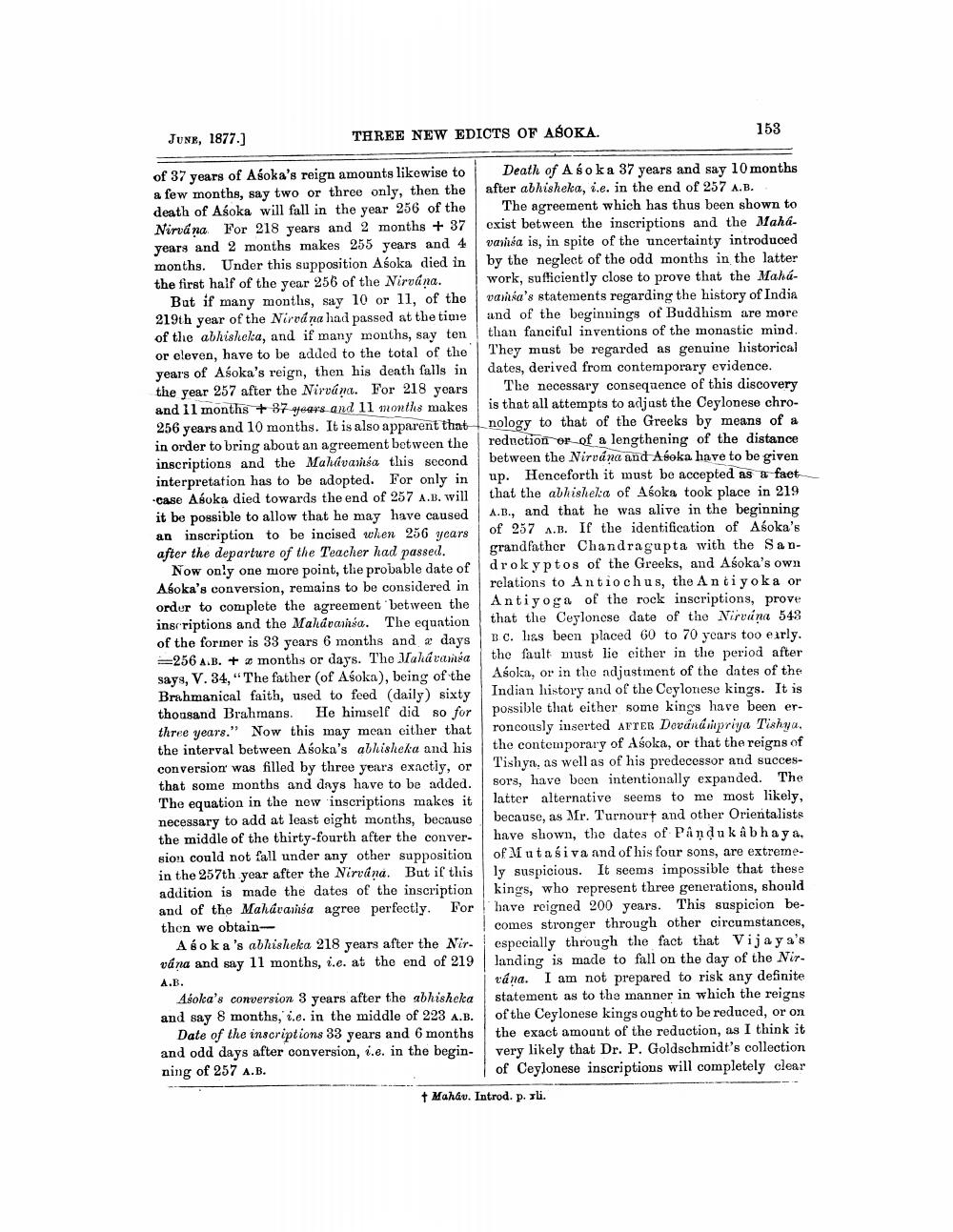________________
THREE NEW EDICTS OF ASOKA.
JUNE, 1877.]
of 37 years of Asoka's reign amounts likewise to a few months, say two or three only, then the death of Aśoka will fall in the year 256 of the Nirvana For 218 years and 2 months +37 years and 2 months makes 255 years and 4 months. Under this supposition Aśoka died in the first half of the year 256 of the Nirvana.
But if many months, say 10 or 11, of the 219th year of the Nirvana had passed at the time of the abhisheka, and if many months, say ten or eleven, have to be added to the total of the years of Asoka's reign, then his death falls in the year 257 after the Nirvana. For 218 years and 11 months+ 37 years and 11 months makes 256 years and 10 months. It is also apparent that in order to bring about an agreement between the inscriptions and the Mahavamsa this second interpretation has to be adopted. For only in -case Aśoka died towards the end of 257 A.B. will it be possible to allow that he may have caused an inscription to be incised when 256 years after the departure of the Teacher had passed.
Now only one more point, the probable date of Asoka's conversion, remains to be considered in order to complete the agreement between the inscriptions and the Mahavansa. The equation of the former is 33 years 6 months and a days
256 A.B. + months or days. The Mahavamsa says, V. 34, "The father (of Aśoka), being of the Brahmanical faith, used to feed (daily) sixty thousand Brahmans. He himself did so for three years." Now this may mean either that the interval between Aśoka's abhisheka and his conversion was filled by three years exactly, or that some months and days have to be added. The equation in the new inscriptions makes it necessary to add at least eight months, because the middle of the thirty-fourth after the conversion could not fall under any other supposition in the 257th year after the Nirvana. But if this addition is made the dates of the inscription and of the Mahavansa agree perfectly. For then we obtain
Aśoka's abhisheka 218 years after the Nirvána and say 11 months, i.e. at the end of 219
A.B.
Aśoka's conversion 3 years after the abhisheka and say 8 months, i.e. in the middle of 223 A.B. Date of the inscriptions 33 years and 6 months and odd days after conversion, i.e. in the beginning of 257 A.B.
153
Death of Asoka 37 years and say 10 months after abhisheka, i.e. in the end of 257 A.B.
The agreement which has thus been shown to exist between the inscriptions and the Mahavamsa is, in spite of the uncertainty introduced by the neglect of the odd months in the latter work, sufficiently close to prove that the Mahávansa's statements regarding the history of India and of the beginnings of Buddhism are more than fanciful inventions of the monastic mind. They must be regarded as genuine historical dates, derived from contemporary evidence.
The necessary consequence of this discovery is that all attempts to adjust the Ceylonese chronology to that of the Greeks by means of a reduction or of a lengthening of the distance between the Nirvana and Asoka have to be given up. Henceforth it must be accepted as a fact that the abhisheka of Aśoka took place in 219 A.B., and that he was alive in the beginning of 257 A.B. If the identification of Aśoka's grandfather Chandragupta with the Sandrok yptos of the Greeks, and Aśoka's own relations to Antiochus, the Antiyoka or Antiyoga of the rock inscriptions, prove that the Ceylonese date of the Nirvana 543 BC. has been placed 60 to 70 years too early. the fault must lie either in the period after Asoka, or in the adjustment of the dates of the Indian history and of the Ceylonese kings. It is possible that either some kings have been erroneously inserted AFTER Dovánámpriya Tishya. the contemporary of Asoka, or that the reigns of Tishyn, as well as of his predecessor and successors, have been intentionally expanded. The latter alternative seems to me most likely, because, as Mr. Turnourt and other Orientalists have shown, the dates of Pândukâbhaya, of Mutasiva and of his four sons, are extremely suspicious. It seems impossible that these kings, who represent three generations, should have reigned 200 years. This suspicion becomes stronger through other circumstances, especially through the fact that Vijaya's landing is made to fall on the day of the Nirvána. I am not prepared to risk any definite statement as to the manner in which the reigns of the Ceylonese kings ought to be reduced, or on the exact amount of the reduction, as I think it very likely that Dr. P. Goldschmidt's collection of Ceylonese inscriptions will completely clear
+ Maháu. Introd. p. xli.




